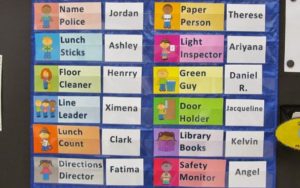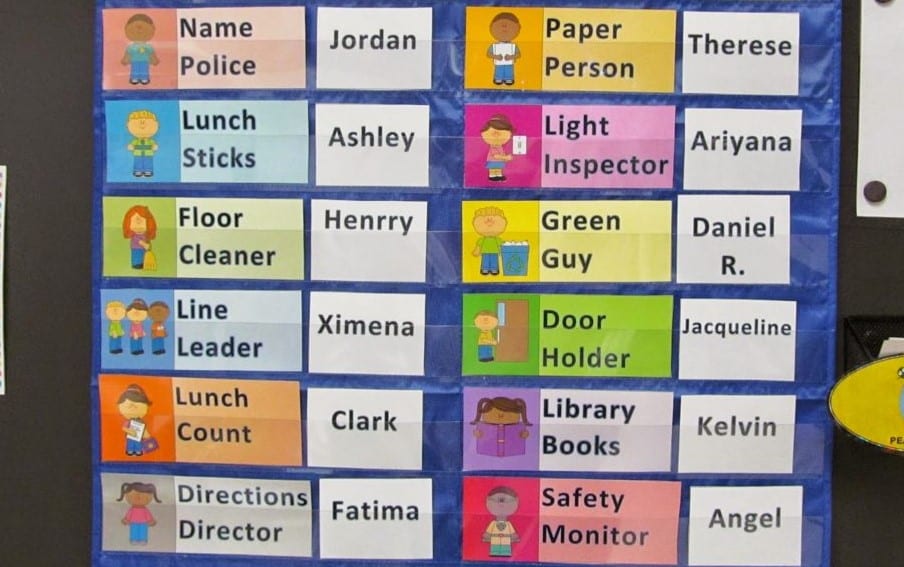Student Contributor: M. Caballero
 Daily tasks are helpful in the classroom because they give students a sense of responsibility with tasks that can differ from day to day. It empowers students by holding them responsible for a given task, assigned by the teacher, which can range from passing out papers to taking attendance.
Daily tasks are helpful in the classroom because they give students a sense of responsibility with tasks that can differ from day to day. It empowers students by holding them responsible for a given task, assigned by the teacher, which can range from passing out papers to taking attendance.
This tool is used every day and can vary from switching tasks each day or keeping them the same over the period of a week. The purpose of daily tasks is to include the students in the classroom by assigning each a “task” or jobs to do for the day. The teacher should create a list of tasks for the classroom at the beginning of the year and then give each student a task to do on a daily basis. Along with this, the teacher should also introduce this system in a way that students will understand what it consists of, then ensure students are doing their tasks until he/she can see that they get the hang of it to do themselves. The tasks assigned should not include ones that will interfere with/disrupt lessons rather those that will benefit the classroom environment. Daily tasks are a good way of incorporating students into the classroom by working together alongside other students to ensure that each task is completely. The teacher can also create a task chart which displays each task and indicates to the students who has was task for the given day.
 The daily tasks tool falls under the Preventative phase. This tool would be within this phase because it is a way for students to build a sense of responsibility within the classroom setting as well as holding fellow students accountable for their assigned tasks. Along with this, it is a good way to show students what should be done in a given day along with giving them the opportunity to complete these tasks. The theory that this tool falls under would be student-directed and the collaborative theory. In this case, the teacher is the one who creates and assigns the tasks that will be given to students, along with keeping up with students for the first couple weeks to make sure the understand what needs to be done. On the other hand, the students are the ones who are actually responsible for completing these daily tasks. This is a collaborative tool in which students and teachers work together to ensure that all of the daily tasks are complete at the end of the day.
The daily tasks tool falls under the Preventative phase. This tool would be within this phase because it is a way for students to build a sense of responsibility within the classroom setting as well as holding fellow students accountable for their assigned tasks. Along with this, it is a good way to show students what should be done in a given day along with giving them the opportunity to complete these tasks. The theory that this tool falls under would be student-directed and the collaborative theory. In this case, the teacher is the one who creates and assigns the tasks that will be given to students, along with keeping up with students for the first couple weeks to make sure the understand what needs to be done. On the other hand, the students are the ones who are actually responsible for completing these daily tasks. This is a collaborative tool in which students and teachers work together to ensure that all of the daily tasks are complete at the end of the day.
More Information –
Tool Source: Cornerstoneforteacher.com and Scholastic.com



I implemented in my classroom the “Daily Task” preventative tool. I am placed in a suburban 1st-grade classroom, with 20 students. The tool was simple to prepare. I thought of 20 different jobs that can be done throughout the classroom and found pictures that relate to the task. I then wrote each of the students’ names on a clothespin to identify which student had what job for the day. The prep time took about 30-40 minutes. To teach the tool, I introduced it during our morning message. It took about 20 minutes to explain the structure of class jobs, the rotation, and what each job entailed. Some jobs can be done throughout the day, others are completed right before the end of the day. I noticed that students really enjoy helping take care of our classroom. The job a student has rotated each week, students love to come in on a Monday and find out their job for the upcoming week. I believe this tool was a success. Our classroom was much cleaner, and I noticed students helping one another more than I had before. Students understood their role with the new tool. Everyone has a job, we all contribute, and I can ask to help others if they need help with their job. I think adjustments to make it better would be giving students more time to complete their jobs. Some days we are very busy getting through content, that students don’t have enough time to properly do their job.